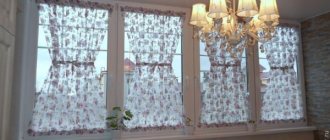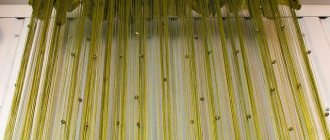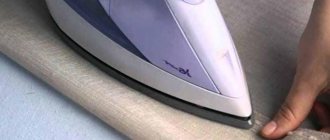The harm of dirty and dusty curtains
Dust constantly collects on the folds of curtains, even if air purifying filters are used in the apartment. This creates conditions for dust mites to multiply.
The waste products of this parasite enter the air that a person inhales. This contributes to the development of chronic diseases of the respiratory system and the appearance of an allergic reaction.
If the window is constantly open, then the curtains will act as a filter, holding back heavy metal compounds and toxin particles. An increase in their concentration in the room air can lead to intoxication.
How often to wash curtains
The frequency of washing depends on many factors. For example, if the window faces a road or industrial area, then the curtains on it will become dirty more often. It is recommended to clean curtains at least 2 times a year. Tulle absorbs dust faster, so it is better to wash it once every 2-3 months (in the summer, when the windows are open, the procedure is carried out more often).
Rules for washing curtains in a washing machine: mode, temperature
Today's variety of drapery materials can confuse even an experienced housewife. The problem lies not only in choice, but, most importantly, in aftercare. Each type requires its own conditions and the correct order of their implementation, and here we will look in detail at how this is done.
Tulle and curtains are the most important detail in the interior, which is paid attention to first.
Important! Before removing the curtains, we advise you to photograph them, especially if they consist of several parts and contain many decorative elements. You will feel the value of this recommendation the next time you hang it. It is often almost impossible to put a composition back together without instructions.
Before starting work, the curtains removed from the window should be prepared.
- Cleaning from dust.
This is done either with a vacuum cleaner with a suitable attachment, or by regular shaking, preferably in the open air. It is difficult to do this alone; we advise you to arrange for an assistant in advance. - Removing fittings.
Remove and put away all accompanying non-woven parts, hooks, rings, cords, bows. Decorative jewelry made from beads, bugles and others should also be carefully removed and placed in a suitable container. If this is not possible, you need to place the curtains in special bags. - Determine the material from which the fabric is made in order to correctly select the desired program.
For a factory-made product, this information is contained on the label; if the product is designer tailoring, it can be obtained from the craftsman. When determining the composition is not possible, it is worth choosing a delicate program. - Select appropriate products for certain types of material and special bags for delicate items.
Curtains can be placed in a fabric bag. - Very dirty items are pre-soaked in warm water with added detergent.
Thin fabrics, such as veil and organza, do not need to be soaked; they wash well anyway.
Note! Do not combine processing of natural and synthetic fabrics in one load.
Almost all types of woven curtains are acceptable for use in a washing machine, the difference lies in the correct setting of the program, water temperature and spin capability. Most types of curtains cannot be wrung out in the washing machine.
Models, especially combined and multi-layer ones, must be carefully sorted and washed separately from other items.
Important! Curtains must be washed at least twice a year. Kitchen ones - at least twice as often, since they become dirty faster due to fumes from cooking. Light and airy curtains require attention more often, at least once every two or three months.
General washing recommendations
When choosing a cleansing method, you need to take into account:
- type and quality of material;
- the presence of decorative elements;
- degree of pollution;
- presence of stains.
Always read the manufacturer's markings on the label affixed to the fabric.
It indicates the type of wash, maximum temperature and spin speed, recommendations for drying and ironing.
Methods for cleaning curtains
Depending on the products and methods used, cleaning can be:
- dry;
- manual;
- using a washing machine.
Handwash
This method is used if the origin of the fabric and its properties are unknown, or the material is too delicate to use automatic equipment. First, the textiles are soaked and only after that the cleaning process begins. Wring out the curtains carefully: it’s better if the liquid drains out on its own.
In an automatic machine
Curtains made from thicker materials can be cleaned using a machine. Curtains cannot be washed with other items or household textiles. In this case, the drum is loaded only halfway, otherwise the dirt will not be washed out.
How to wash curtains by hand
To wash curtains that are delicate in composition or the type of fabric is unknown, it is recommended to use the manual wash cycle. Washing by hand is a gentle way to clean fabric, so it is suitable for all types. The method allows you to control the process from beginning to end, working through problem areas.
When preparing curtains for washing, it is convenient to use a vacuum cleaner to remove dust.
Algorithm of actions:
- Removing dust from the surface.
- Soaking with a cleaning solution to subsequently remove stains. For severe stains, it is worth soaking twice: first in a saline solution (soaking for an hour, rinsing), then in a soap solution using a liquid detergent.
- Performing the main wash. If necessary, use a stain remover or bleach if the fabric allows.
- Rinse to remove product residues with repeated changes of water.
- Hanging to allow liquid to drain.
- Drying.
When hand washing, removing hooks is not necessary. While it is prohibited to wash curtains with hooks in a washing machine, even if you have a laundry bag. They can damage the material and leave snags. If the wash is carried out without the bag and the hooks are not removed, there is a risk of damage to the machine mechanism.
Despite the significant advantages, washing by hand also has a disadvantage associated with the labor-intensive process.
Preparatory stage
Before washing we recommend:
- Remove decorative elements and metal fasteners (if possible).
- Shake the fabric several times to remove dust.
- Inspect the material for stains. If there are stains, they can be washed off using stain removers.
- Soak the curtain in soapy water (if there is too much dust, the procedure can be repeated several times).
In the washing machine
Using an automatic machine to clean curtains is much easier and more effective. But it is important to choose the right special means and the appropriate regimen.
General rules
To avoid damaging the curtains, you need to follow simple recommendations:
- The fabric must be folded carefully before being loaded into the drum.
- If the product is decorated with beads, beads and other elements, then it must be folded with the decorations inside and washed in a special protective case.
- It is preferable to use liquid cleaning products (gels), because... The loose powder dissolves slowly and is difficult to wash out of the fabric.
- You need to choose the right mode and add at least 1 rinse.
Select mode and temperature
It is advisable to dry clean velvet curtains so as not to lose the appearance of the material when washed.
If this is not possible, turn the items inside out so that they do not spread out in the drum. Set the delicate mode at 30 degrees. It is best to choose the minimum time for washing; with prolonged exposure to moisture, the material may shrink. Nylon curtains must be straightened before washing, and not folded into a lump. You can wash in any mode, the main thing is to turn off the spin cycle.
Naturally colored linen can be washed at 40 degrees, and dyed fiber at 60. Linen curtains can be washed on the cotton cycle.
For satin, set the temperature to 40 or 60 degrees, depending on the severity of the dirt. Select the delicate mode or the Cotton program. Set the spin speed to 600 rpm.
The tulle is first soaked in cold water with bleaching detergent. Set the temperature to 30-40 degrees, and reduce the spin speed to 400.
Organza, silk and veil are washed at a minimum temperature of 30 degrees and only on a delicate cycle or on the “Hand Wash” program. There is no need to soak these products; dirt comes off very easily. This allows you to completely avoid using washing powder or other detergent. It is best to put the curtains in a special bag so as not to damage the delicate material. Machine washing with other items is prohibited. Spin cannot be used either.
Curtains with eyelets should be washed in a special bag to avoid damage to the fasteners and parts of the machine itself. Select a gentle mode and set the temperature at 30 degrees. It is better to use hair shampoo instead of powder. If the eyelets are made of plastic, remove them before washing.
It is better not to wash items with rhinestones, embroidery or other decor yourself. Take them to the dry cleaner.
Selecting an automatic washing mode by fabric type
If the curtains do not have decorative trim, they can be easily cleaned in a machine. The main thing is to choose the right temperature and washing program depending on the type and color of the fabric.
Cotton and linen
These materials are the most unpretentious and easy to clean. Cotton flaps can be washed at 50-60 °C. If the curtains are plain and light, then the indicators should be increased to 70-80 °C.
As for flax, the optimal temperature is 40-50 °C. You need to rinse the fabrics at least 3-4 times, and at the final stage it is better to do this with the addition of a small amount of conditioner (it will make the material softer and more pliable).
From taffeta
It is better to dry clean such curtains. But if there is a need to wash them at home, then this should be done at 40 °C in the delicate mode. It is mandatory to use conditioner for delicate fabrics. It is not recommended to unscrew the products, because... the material may tear or become deformed.
It is better to hang the curtains and wait for the water to drain naturally.
Silk, wool
Silk or chanzelize curtains look elegant and expensive. But such fabrics are whimsical and require special care. It is better to wash them by hand or in a machine, setting the delicate cycle without spinning. We recommend additional rinsing of the fabric using conditioner.
Nylon and chiffon curtains
For such products, manual cleaning mode at 30 °C is suitable. You can install an additional rinse, since it is difficult to wash out the powder from the fabric.
Automatic spinning is contraindicated.
Viscose, polyester, other synthetics
When it comes to polyester, spandex and other synthetic materials, you need to be careful. Such fabrics do not tolerate high temperatures well, so it is better to wash them at 30-40 °C. It is better to wring out the curtains at minimum speed (you can even stop twisting them altogether).
Nylon
This material quickly becomes covered with dust, so it is recommended to wash it at least once every 2 months. Since nylon is soft and delicate, it can only be cleaned manually/delicately. The temperature should not exceed 30 °C. It is better to disable the spin function.
Before putting the curtain into the machine, you need to soak it in a soda solution for 30-60 minutes.
Blackout
Such curtains are made of hard, dense fabrics that do not let light into the room. Since the material is quite resistant to the external environment, washing is unlikely to become a problem. For curtains, the standard mode and temperature of 40 °C are suitable. Spin speed – no more than 600 rpm.
Velvet and other pile curtains
Velvet and velor curtains are more suitable for dry cleaning. But sometimes products need to be washed, because... Dirt and dust accumulate between the pile. First, the curtains are carefully knocked out, and then folded with the front side inward to form a narrow rectangle. It is recommended to roll the resulting strip into a roller and place it in a case, only then send it to the drum of the machine.
Wash on a delicate cycle at 30-40 °C (it is better that the process lasts no more than 30-40 minutes). You cannot wring out fluffy fabric - this function must be eliminated immediately.
To dry the curtains, they are not hung, but laid out on a horizontal surface - this way the product will retain its shape.
Washing items with decor
Cleaning models with decorative elements should be taken more responsibly. You should take into account not only the characteristics of the main fabric, but also the finishing material. If possible, the decor should be removed. Otherwise, it is better to wash by hand or using a protective cover.
Models with eyelets
These are large rings sewn into the fabric through which the rod of the cornice passes. Care must be taken when cleaning. The eyelets may come off or ruin the quality of the fabrics. If these elements are made of metal, then contact with water can cause them to become rusty, resulting in orange and brown stains appearing on the fabric of the curtains.
If the eyelets are removable, then it is better to remove them before the procedure. In the case where the elements are sewn into the fabric, the curtains are washed only in a special protective mesh cover. It is recommended to set the delicate mode and low temperature.
After washing, areas with decorative elements must be dried thoroughly.
What determines the frequency of washing?
The type of fabric from which the curtains are made affects not only the external characteristics of the product, but also the washing methods. There are curtains that are contraindicated for machine washing. There are also those who tolerate the procedure completely calmly, even at high temperatures.
Features of washing curtains - division by fabric type:
- Silk, satin, organza, veil. Washing in a gentle cycle in an automatic machine is acceptable. The maximum temperature level of water is 30 degrees. No soaking or spinning required. The choice of product is capricious - abrasives are contraindicated, gels are preferred.
- Acrylic, viscose. Machine washable at a temperature not exceeding 40 degrees on a delicate cycle. Products for delicate fabrics are indicated for use. Acrylic requires the use of a conditioner to keep the fibers soft. Drying is natural, but ironing through damp gauze is allowed.
- Linen. Due to their low maintenance, linen curtains are ideal for kitchens where soot particles constantly settle on surfaces. A canvas contaminated with traces of soot and yellowed by temperature changes can only be saved by liquid-based oxygen bleaches, since the use of products with chlorine is unacceptable. To remove stains from white fabrics, also use bleach, and stain removers with enzymes can help remove complex stains, such as traces of soot and soot. At high temperatures in the “Cotton” program, the availability of ironing in a damp state - all this is about linen curtains.
- Cotton. Cotton curtains can shrink when machine washed and aggressively dried, so you should choose hand ironing and ironing with a damp cloth.
- Polyester. Can be washed at a temperature not exceeding 40 °C degrees. Ironing is permissible, but through damp cloth. Colored ones are washed using powders for delicate fabrics, white ones - universal.
- Taffeta curtains, like any synthetic fabric, require exclusively hand washing. It is possible to wash a heavily soiled taffeta curtain only after soaking. Aggressive means and manipulations (washing, spinning) are contraindicated. Drying in direct sunlight or near heating appliances is prohibited - following the rules will protect the curtains from yellowing, which will be detrimental for this type of curtain.
- Velvet. Washing velvet curtains at home is not advisable. The material will fade and lose its presentability. Preference should be given to dry cleaning and professional dry cleaning. For velvet curtains, hand washing at 30 degrees is allowed, but not recommended. Manipulate quickly to minimize contact of the velvet with water. Drying should only be done horizontally.
- Nylon. Curtains are said to be easy to wash. But do not forget that you should wash them separately from other things - there is a risk of acquiring an unpleasant grayish tint. Regular starch will help protect nylon from graying: just add potato starch to the solution. The trick will not only avoid the unwanted, but also whiten the once white curtains.
- Wool. Washing in a machine is allowed in the presence of the same mode. If not available, only manual. The procedure takes place without prolonged soaking, at a temperature not exceeding 35 °C. The temperature must be stable from start to finish. Dry exclusively horizontally.
We can conclude that textiles without decoration are quite easy to care for - you just need to remember the subtleties associated with the modes, and the right decision when choosing a washing method will not be difficult.
How to wash organza You will learn: how best to wash - in a machine or by hand; method of washing organza in a washing machine and by hand; how to wash without ironing; drying rules and...
It is worth understanding the difference between curtains with and without decor. In the first case, when choosing methods, you will also have to focus on the features of decorative elements.
Curtains require special care:
- Blackout. The absence of a metal or acrylic layer indicates that it is machine washable. If there is a blackout coating on the curtains, only hand washing is allowed. As a product, choose solutions for synthetics and wool. Laundry soap will do. Select a program with a temperature not exceeding 40 °C.
- Tapestry. Wet cleansing is not advisable. If necessary, clean with a vacuum cleaner once a season and remove dust with a damp cloth.
- Roman. Only fabric items are allowed to be washed. To perform the procedure, the slats must be removed and the material washed by hand. The slats are returned to place while the fabric is damp.
- Flock. Can be washed on a delicate cycle. Any spin is prohibited, as is overloading the drum. Dry naturally by hanging.
- Japanese curtains are curtains that require special care because they can be made from any materials. Often fabric manufacturers combine fabrics, so the only option for washing is by hand. They also have common features - the fabric is thin, so it is recommended to wash them as rarely as possible. The temperature should not exceed 30 degrees. Spinning and ironing are excluded.
Japanese Flock Roman Blinds Tapestry Blackout
Remember that in order to preserve the appearance of curtains for a long time, you should properly care for them using exceptional soft products.
How to wash Roman blinds You will learn: features of washing Roman blinds; how to remove them correctly; how to wash by machine and by hand); and also how to clean without washing, if...
Eyelets are rings that frame the holes into which the cornice is threaded. The material from which the eyelets are made depends on the possibility of removing the rings. Plastic ones are often removable, as there is a risk of deformation. Metal ones are more static.
Do not be afraid that the metal rings will corrode after washing. Modern manufacturers try to use high-quality metal that is not capable of harming the material. A big danger is the grommet separating from the curtain fabric - use laundry bags to prevent this problem.
The correct way to wash curtains with eyelets in a machine wash is to use a delicate program with the spin mode turned off. Strong friction, and even more so twisting, are contraindicated. The permitted temperature usually does not reach 40 degrees. The detergent is selected based on the type of fabric, with preference given to liquid detergents. They are easier to rinse out than powder.
Washing curtain threads is allowed both manually and in an automatic machine. But in any of these options, curtains require preliminary preparation, which consists of tying the threads. If you plan to hand wash, tie them with braid at an equal distance from each other. To prevent the braid from unraveling during machine washing, it is recommended to weave the threads in the form of braids.
We invite you to read: How to choose an iron for home use: parameters for the correct selection of good devices, sole features and additional functionality
When the braids are formed and it’s time to put the muslin curtains in the machine, don’t forget to create an additional protective barrier in the form of a bag or pillowcase. Thanks to a slight nuance, the possibility of tangling will be minimized.
Choose only delicate washing modes and mild detergents. From the available range, washing gels are ideal. It is better to move products in powder form to the spare shelf.
The permissible temperature is 40 degrees with a spin speed of no more than 400–500 rpm.
After completing the process, hang the curtain over the bathtub, untie the ribbons and braids. Straighten the threads to remove any creases. Should be dried flat.
Curtains with eyelets can be washed in a washing machine. As a rule, eyelets are made of stainless material, so they do not need to be removed before washing.
- Remove the curtains from the curtain rod.
- Prepare water with liquid detergent.
- Place the curtains in the laundry net.
- Pour the product into the special compartment, select the washing mode suitable for the type of fabric of your curtains.
- Remember: if you have curtains made of moire, brocade or velvet, it is better to take them to the dry cleaner.
No interior, even the most sophisticated one, will look complete without windows decorated with curtains. Today, the textile industry offers housewives a real abundance of various fabrics. However, as a rule, when choosing curtains for the home, we very rarely think about how we will wash them.
It’s hard to believe, but light and delicate curtains are one of the main obstacles blocking the path of dirt and germs into our home, taking on up to 80% of all exhaust gases and street dust. That is why the more often you wash curtains-dust collectors, the better. Even if the curtains look clean, rest assured, they are full of dirt and dust. Today we will share with you a few secrets that will not only protect your curtains from getting dirty, but also extend their service life.
— Before washing curtains, it is necessary to distribute the laundry according to color and temperature conditions. Before washing, stains should be treated in accordance with the recommendations for the care of this type of product.
— The washing machine drum should be filled to 50%, which will ensure effective, gentle washing, easy rinsing and spinning. Curtains must be rinsed thoroughly to ensure that no detergent remains on them, because solar radiation can cause a reaction between the residues of washing powder and bleach and fabric dyes - as a result, the curtain will be damaged.
— It is always necessary to iron curtains while damp, since ironing and steaming retain their shape. To iron over seams, you need to place a piece of fabric inside, between the seam and the main fabric, so that a scar does not form. Products with embroidery must be ironed from the reverse side.
For white cotton, use an all-purpose detergent; for colored fabrics, use a detergent for delicate fabrics or a detergent without optical brightener. Drying cotton fabrics in a dryer can cause severe shrinkage, so this type of drying is only recommended for items that have the approval symbol on the label. Cotton items are easy to iron, especially with a little dampness.
Features of cleaning curtains of different designs
Curtains of unusual design require special care, because... Improper washing can easily ruin their appearance.
Thread curtains
Curtains made of thousands of thin threads look impressive. But dust collects between the tapes, so you need to clean the curtains often. Before washing, it is better to braid all the threads into thick braids or twist them into bundles and tie them with a rope. This way they won't get confused.
Place the curtain with the rewound elements in a mesh case. Wash at a temperature of no more than 30 °C. It is better to return the curtains to the curtain rod while still damp - this way the threads can straighten out quickly.
Roman and roll systems
Wet cleaning of such models is recommended to be carried out as rarely as possible. If you regularly remove dust from the fabric with a vacuum cleaner and periodically use a steam generator, then you need to wash the curtains no more than once every 1.5 years.
The fabric must be carefully removed from the mount, folded and placed in the case. Set low temperatures and do not twist.
Japanese curtains and pleated
Pleated curtains are recommended to be cleaned by hand. It is enough to soak the fabric in a soapy solution, and after 40 minutes take it out and rinse several times. The curtains will lose their shape in the washing machine.
As for Japanese curtains, they are made of plastic, bamboo or rattan. They need to be periodically cleaned with a vacuum cleaner or washed with a sponge soaked in soapy water. Machine washing is contraindicated.
French
Such curtains are made from light, airy materials. They are multi-layered and often decorated with beads and ribbons, so you need to be careful when cleaning the products. It is better to place the fabric in a protective case. We recommend hand washing using a mild cleansing gel.
Washing lambrequins
The technique for cleaning lambrequins depends on the type of fabric. If the decorations are made of silk, wool or velvet, then it is better to dry clean them. Linen and cotton items can be rinsed by hand in a soapy solution. Organza, polyester and tulle are machine washable using a delicate cycle.
How to wash curtains and tulle in a washing machine
Tulle and curtains require different care. Thin tulle can be washed by hand, soaking it in detergent for delicate fabrics, or in a machine on a special cycle.
- Place the tulle in the washing net.
- Soak it for 2 hours in warm, but not hot water with detergent.
- Place the tulle in the washing machine and set it to a delicate cycle and a temperature of no higher than 30 degrees.
- After washing, the tulle can be ironed at the lowest temperature.
- Thick curtains are washed using the same algorithm as tulle. Just remember to turn off the spin cycle and select the setting for your fabric type.
- 10 foods you've been storing incorrectly all this time
To preserve the appearance of the product in the machine, it is not recommended to wash it:
- Woolen. Exclusively by hand using liquid products.
- Velvet. Cleaning velvet curtains in a washing machine is disastrous - the pile rolls off, gets knocked down, becomes hard, and loses its appearance. Ideally use dry cleaning.
- With permanent decor. Small items can cause machine damage.
- Curtains with a metallic or acrylic layer. Active friction in the machine can ruin the coating.
For other types, the use of a washing machine is permitted.
To determine the correct way to wash your curtains, refer to the information on the label. The manufacturer's recommendations will help you understand whether the material requires gentle hand washing or whether automatic washing is allowed. If the product is made to order, check the composition with the craftsman. If it is taken by hand or the label with information is simply lost, protect yourself from damage to the item and resort to hand washing.
Detailed instructions for properly washing curtains in a washing machine.
Preparing for washing
Before washing the curtain, you need to first prepare it. Preparation will consist of performing a set of activities related to soaking, treating stains and choosing a detergent. Each of the points is the key to successfully cleaning the fabric from contamination.
Algorithm of actions for preparation:
- Shaking off dust.
- Elimination of defects - protruding threads, loose seams.
- Removing hooks and fittings.
- Soaking is only required if there are greasy stains or heavy dirt. The effect is exerted through general soaking or local application to problem areas. Soaking lasts for 30–60 minutes after which, if necessary, you should begin soft washing.
- Rinse in clean water to remove any remaining dirt.
It's time to load the curtains into the washing machine. Consider the weight of the products. Do not exceed the permissible limit. Weigh raw. Failure to comply with the rule can lead to damage to equipment and poor quality of washing.
The washing mode directly depends on the type of fabric. If the fabric is classified as delicate, a gentle mode is selected. For curtains made of silk - “Silk” or “Wool”. But more often than others, the “Gentle”, “Delicate”, and “Hand Wash” programs appear.
If the machine does not have a delicate or gentle mode, choose silk or wool.
If there is a pre-soak or rinse function, it is worth using them.
For delicate fabrics, the permissible temperature limit is 30-40 °C, which will allow you to carefully clean the material from contaminants without disrupting the connecting functions of the fibers. Durable fabrics without decoration can be washed at 60 degrees, but not higher.
A careless attitude to choosing the temperature can lead to:
- formation of pellets;
- yellowing;
- deformation of matter.
For delicate fabrics, choose a temperature of 30-40 °C, for others - 60 °C.
Which spin to choose
For most curtains, machine spinning is not recommended due to the possibility of creases and folds.
To eliminate excess moisture, prepare the area above the bathtub to allow natural drainage.
- How often should you wash curtains?
- We wash different types of curtains
- How to wash tulle
The main dust collectors in your home are curtains. Dust and odors settle on them. Therefore, it is very important to wash your curtains regularly. If you don’t do this, all the absorbed dirt will go straight into your body.
To prevent dust from accumulating inside the material, it is enough to wash the curtains every 3-4 months. If from time to time you clean the curtains with a vacuum cleaner or brush, washing can be done less often - once every six months.
Unlike curtains, tulle gets dirty much faster, especially the one hanging in the kitchen. It absorbs food odors, causing it to turn yellow and gray. Therefore, tulle must be washed once every 2 months.
Regardless of the type, all curtains should be washed with liquid powder. This product rinses well and does not leave unpleasant stains on the material. In order for the curtains to retain their original appearance after washing, you must:
- Before loading the machine, shake out excess dust from the curtains.
- Wash at a temperature no higher than 30 degrees.
- Wash curtains using hand or delicate wash.
If you decide to wash your curtains in the washing machine, do not fill the drum more than half full. This way the curtains will wash much better and remain intact.
All curtains can be divided into 4 groups:
- Curtains with eyelets.
- Filament curtains.
- Roman curtains.
- Roller blinds or roller blinds.
Depending on the type of curtains, the process of washing them will have its own characteristics.
Before washing, curtains with eyelets must be placed in a special bag. It will serve as protection for the washing machine drum, which can be damaged by metal fasteners. Before washing, the plastic eyelets can be removed without using the protective bag.
When washed in a machine, thread curtains may become tangled. To avoid such consequences, tie the threads by color and place the curtain in a protective bag.
The peculiarity of curtains made of threads is that they are washed very easily and quickly. Therefore, there is no need to continue washing for more than 30 minutes.
Don't be afraid to wring out the curtains in the washing machine - nothing will happen to them. And so that they take their shape, after washing, hang them in place and let them dry.
Before you start washing your Roman blinds, be sure to pull out the slats. This type of curtain may require additional rinsing as detergent often accumulates in the rail openings.
If you forget to re-rinse, the remaining liquid powder reacting with metal, wood or plastic inserts can change the color of the curtains and leave unpleasant marks on them.
Roller blinds differ from others in that they cannot be wet. For cleaning, use dry wash methods only. To remove dirt from roller shutters, use a vacuum cleaner or soft brush. It is best if you take them to dry cleaning: with the help of special products and steam, the workers will clean the roller shutters perfectly.
Washing tulle must be carried out in a delicate wash mode at 30-40 degrees water temperature. For washing, use the simplest powder. If desired, you can add a little oxygen bleach to it - about 1 tablespoon. It will help maintain the snow-white color of the material.
To refresh the color of the tulle, before washing it in the washing machine, soak it in cold salt water for about 1 hour. After this procedure, the tulle will look like new.
To prepare a bath for curtains, add 1 tablespoon of salt to 1 liter of water.
Clean curtains and tulle will refresh the room and protect you from excess dust in the house. Now you know that you don’t need to go to the dry cleaner to do this: you just need to wash the curtains at home, in the washing machine.
Professional dry cleaning of curtains at the factory
Water cleaning using bleaches and stain removers can only be carried out in rooms specially designed for this purpose. During its implementation, aggressive chemical compounds are often used.
The evolution of cleaning products
The first laundries and dry cleaners appeared in France. Just a few decades ago, petroleum products, including kerosene and gasoline, were used to clean fabrics. But as the chemical industry developed, more effective and safe products appeared.
Perchlorethylene
This is an organochlorine solvent that quickly removes any stains from fabrics. It is used for professional machine cleaning. Do not treat fabrics with bright colors or patterns with this solution, because this will cause color loss.
Hydrocarbon
This product is more environmentally friendly and harmless. It does not affect the color, texture, or shape of matter. Hydrocarbons are often used to process designer items, curtains with rhinestones, beads and other decorative elements.
Silicone solvents
These products are gentle even on thin, delicate materials. But they are slightly soluble in water, so not all stains can be removed with their help.
How to choose the right dry cleaner
The choice of dry cleaning service should be taken responsibly, because... Using incorrect equipment or products may damage the product. Before handing over the curtains, it is worth asking what machines and stain removers are used to clean the material, what guarantees the company gives and whether they will compensate you for losses if the curtains are damaged during processing. Read customer reviews.
Whitening curtains at home
Over time, tulles and curtains made from light-colored materials become dull or covered with yellow spots. The means at hand will help you get rid of dullness.
Salt
Add ½ cup of salt and powder to 10 liters of water. Immerse the tulle in the resulting solution and leave overnight. This procedure will help make the curtains snow-white.
Soda
If you need to bleach curtains, use baking soda. Dissolve 2 tbsp in 5 liters of water. l soda and ½ cup washing gel. Immerse the product in the prepared mixture and leave for 40 minutes.
Ammonia
Products based on ammonia and hydrogen peroxide are often used to care for white curtains. Preparing a solution for soaking is simple: dilute 60 ml of peroxide and 30 ml of ammonia in water. Keep the tulle in water for no more than 30 minutes.
Zelenka
The brilliant green helps return the tulle to its snow-white color. But you need to use it carefully so as not to dye the fabric light green. In 10 liters of warm water, add 10 drops of brilliant green and 2 tbsp. l. salt. Immerse the curtain in the solution for 5-10 minutes.
Blue
This dye will help give the material an icy tint. You need to dilute 10-15 drops of blue in 10 liters of water. It is recommended to soak clean tulle for 10-15 minutes and then rinse.
Boric acid
Dilute 60 ml of boric acid in 10-15 liters of warm water, then soak the fabric in the solution for 2 hours. This remedy helps get rid of yellowness.
Velvet
Typically, such products are not washed at home; they are cleaned with a vacuum cleaner or brush, and for deeper cleaning they are sent to a specialized company. If this is not possible, and the velvet curtains need to be washed, you can try to do it yourself, but a positive result cannot be guaranteed. Therefore, you need to strictly follow the recommendations on how to wash velvet curtains.
Useful
We suggest you read How to get rid of ants: the best folk remedies
Before putting them in the washing machine, velvet curtains are folded inside out into a long strip, the width of which is equal to the depth of the drum. Then it is rolled into a cylinder and placed inside. This way they will not become deformed and the pile will not be damaged.
- The washing time is set to the minimum, “silk” mode.
- The water temperature should not exceed 30 °C.
- You cannot squeeze or twist.
- Velvet should be dried flat on a horizontal surface, face up.
Features of bleaching depending on the curtain material
When choosing a bleaching method, you should take into account the material and quality of the curtains.
From nylon
Nylon has a delicate texture, so you should not use chemically aggressive agents for whitening. Citric acid will help restore the whiteness of tulle. It can be added to the soaking water and poured into the washing machine (in the rinse aid tray).
From organza
Organza is an even more delicate material. If we are talking about white matter, then peroxide can be used during cleaning. If the fabric has colored patterns or embroidery, it is better to soak the product in a saline solution.
From the veil
Ammonia is suitable for cleaning air veil curtains. It needs to be added to cool water, then soak the curtains in the resulting solution.
How to wash blackout curtains
Blackout are light-proof curtains that allow you to darken a room even on a sunny day (useful for those who like to sleep during the day). Blackout curtains seem difficult to maintain, but they are not. They can be washed in a machine if they do not have an acrylic layer or metal coating. Otherwise, follow the instructions below.
- Remove the curtains from the curtain rod along with all their components.
- Soak clips, eyelets and other parts in a separate container.
- Apply a little detergent to the curtain fabric in the least visible place, rinse and let dry. If the color has not changed in this area, then the detergent can be used to wash the curtains.
- Place the curtains in the washing machine, select a delicate cycle and a temperature no higher than 40 degrees. Turn off spin.
- Fill the machine with the product you tested in step 3.
- Once washing is complete, hang the curtains back on the window to allow them to dry properly.
The most common types of stains on curtains and how to remove them
Curtains often get stained (especially in the living room or kitchen). Most often you can see marks on fabric from:
- fat and food;
- water (if there are pots with indoor plants on the window);
- tar and nicotine (if there is smoking indoors);
- paints, chocolate, plasticine (especially if children live in the house);
- coffee, tea and other drinks.
Every stain can be removed quickly if you know what cleaning products to use.
Wine, coffee and tea stains
A spilled drink quickly eats into the fibers of the curtain, so you need to act quickly. The older the stain, the more difficult it is to remove.
First, remove the product from the curtain rod, remove excess liquid with a paper napkin and treat the stain with a cotton pad soaked in alcohol or vodka. Then prepare the solution by adding 1 tbsp to 1 liter of water. l. dishwashing detergent and table vinegar. Soak the fabric in this liquid for 30 minutes, then rinse.
Soot marks
Soot and soot quickly settle on the surface of the fabric and penetrate into the fibers. Simple washing will not help get rid of the gray tint. Requires special treatment with soda or turpentine.
Turpentine
First, thoroughly moisten the contaminated cloth with it, and after 10 minutes, wipe with a napkin. Then clean the stain with soapy water. During the procedure, it is better to use gloves to protect the skin of your hands from burns.
Soda
Baking soda helps with soot. First, wash the stains with dishwashing detergent, then immerse the fabric in a soda solution (2 tablespoons of powder per 1 liter of water) and leave for 8 hours.
Grease stains
It is much easier to remove fresh fat from the material. You must first sprinkle the fabric with soda, starch, salt or other adsorbent powder, and then wash it in hot soapy water. If the fat has already become ingrained, then the curtain will have to be soaked in a solution with ammonia and glycerin.
Tulle curtains
Tulle comes in different compositions:
- cotton;
- silk;
- viscose;
- polyester.
Tulle curtains with hooks and eyelets are hand and machine washable. Kitchen ones - more often, moisture, dust, and grease settle on them. Temperature 30 degrees, in a special bag or old pillowcase. For white tulle, oxygen bleach is used.
Do new curtains need to be ironed? If yes, then straighten it and hang it on the cornice using fasteners, moisten along the entire length, they will straighten out under their own weight.
We suggest you read How to quickly get rid of the smell of burning in an apartment
Useful tips for adding freshness to tulle curtains
- You can bleach with a saline solution: soak the curtains in it for 3 hours, then wash as usual.
- Using greenery. Dilute 5 drops of brilliant green in a glass of warm water, after dissolving, mix with 5 liters of warm water, soak pre-washed curtains in this solution for 5-7 minutes. Rinse well afterwards.
- Rub half a piece of laundry soap and dissolve in warm water. Then wash and rinse well.
Methods for cleaning curtains (without removing them)
Sometimes curtains can be cleaned without water without removing them from the curtain rod. These methods are used when dust needs to be removed.
Dry cleaning
This type of cleaning is carried out with a vacuum cleaner using a special narrow attachment with a soft brush. It is better to process the upper part of the product (closer to the cornice), since dust accumulates in this area first.
Wet cleaning and steaming
If we are talking about roller blinds made of dense materials, then from time to time they can be treated with a sponge dipped in soapy water. If you have an iron with a vertical steam function, then with its help you can not only clean dust from the material, but also refresh and disinfect it.
Automatic machine to help
A variety of products are sewn from light and transparent fabric, from underwear to capes and bedspreads. But most often tulle is used as curtains. Washing them by hand at home is not always convenient due to their large size, so why not use a washing machine.
Here are some simple tips on how to wash tulle in a machine.
- Tulle is not afraid of soaking, so washing time does not matter.
- To prevent fraying of delicate fabric, set the spin speed to the lowest possible speed.
- The washing temperature may vary depending on the type of fabric. Most often it is 30-40°, no more.
- It would be wise to wash expensive tulle on a delicate wash program.
- Lay the fabric by folding it evenly, and not crumpling it haphazardly. This will help avoid severe bruising.
If we are talking about small-sized items, then they can be placed in a special bag for washing clothes or in a pillowcase. This will help you wash more carefully and not disturb the structure of the material.
How to starch clean curtains
This can be done using special products sold in the store. But the solution is also easy to prepare at home. Dissolve 5 tbsp. l. potato starch in a glass of cold liquid.
Heat 5 liters of water on the stove and slowly pour the prepared mixture into it, stirring constantly. The resulting paste must be cooled, poured into a bowl or bath, and then soak clean curtains or tulle in the prepared solution for 30 minutes.
Many housewives note that after this procedure the curtains shrank. This problem can be solved. After immersion in the paste, the products must be dried in a vertical position - this way the shape of the curtains will be restored under the influence of gravity. You should start ironing when the curtains are still damp.
Why starch tulle?
Just a few years ago, every housewife starched tulle, towels and bed linen. Now this tradition is fading into the background. But such a procedure has a number of advantages.
Starch envelops the fibers of the fabric. This impregnation has dirt-repellent properties, because dust does not settle on the fibers of the material, but is absorbed by the carbohydrate layer. During washing, the starchy shell dissolves, and along with it, the stains quickly disappear. Curtains do not turn yellow over time.
Starching provides other effects:
- matter becomes denser and less susceptible to damage;
- ironed, starched curtains make the entire interior of the room tidier;
- the pattern on light tulle becomes clearer;
- The fabric does not wrinkle and holds its shape for months.
Starching methods
The procedure can be carried out either manually or using an automatic machine (the starch solution is placed in the rinse aid compartment).
Depending on the concentration of the paste used, there are 3 types of starch:
- soft (1 tsp starch per 1 liter of water);
- medium (1 tbsp);
- hard (2 tbsp).
Finishing without starch
Starch is not the only finishing agent used. The following components have the same effect:
- Sugar that needs to be dissolved in hot water. The mixture cannot be brought to a boil, because... in this case, a syrup is formed that will leave yellow stains on the fabrics. Sugar will give the material a sweet smell that attracts insects.
- Gelatin is well suited for finishing synthetic fabrics (3 tablespoons per 5 liters of warm water will be enough for the procedure).
- PVA glue not only helps make the fabric denser, but also eliminates the gray tint and makes the material smoother and shiny.
- Silicone glue is suitable for processing delicate and delicate products.
Features of washing thick curtains
Thick curtains include curtains made of satin, velvet, taffeta, and linen. These can be curtains of the following types:
- roll;
- Roman;
- Japanese;
- multi-tiered lambrequins;
- regular ones on hooks.
Prolonged washing, the use of aggressive powders and gels, and contact with high temperature water are very undesirable. Therefore, first you should vacuum the curtains, no matter what type or type they are, or at least thoroughly shake off the accumulated dust. If individual stains are noticed, you can try to wipe them off from a dry cloth with a paper eraser.
Did not help? The stain is then treated with a suitable product depending on its origin and type of fabric. After this, the curtains can be washed completely in an automatic machine or bathtub. Roller, Roman or Japanese curtains simply cannot be rolled up and placed in the drum of a washing machine. How to wash such curtains in the bath?
- First, prepare a liquid washing solution - dissolve powder, gel or soap in warm water.
- Then, using a sponge or soft brush, apply it to the curtains and clean them.
- Finally, the textiles should be rinsed well. This is best done using a shower.
- Curtains of this design are dried in a horizontal position. For convenience, you can place stools in the bathtub and straighten the curtains over them. When all the water has drained, the wet curtains are moved to a clothes dryer or table and dried there.
- It is not recommended to immediately hang damp curtains on the curtain rod - the fabric may stretch under its own weight.
Silk curtains should be washed with special care, even the material is dense. Only liquid products are used, the maximum water temperature is 30 degrees.
If you are using an automatic machine, you will need a special bag or an old pillowcase for silk curtains. Silk with the addition of viscose can be washed at a temperature of 40-45 degrees; in hot water they can fade and become deformed.
If the curtains have metal eyelets - rings sewn into the fabric through which the cornice is threaded - then they cannot be completely washed even in the bathroom; rust may appear on the fabric around the rings. How to solve a problem? The top edge of the curtains hangs over the edge of the bathtub. And then the curtains are cleaned as recommended above.
Proper drying of curtains
In order for curtains to retain their attractive appearance for a long time, they need to be dried properly. It is not recommended to wring out the curtains, because... This makes them writhe. If we are talking about tulle, thin silk or organza, then such products can be immediately hung on the windows. It is recommended to dry cotton and linen fabrics at room temperature (if a heater is running in the apartment, the material may shrink).
Curtains made of velvet, taffeta, as well as products with drapery are best laid out horizontally. If you dry them by weight, the product may lose its shape. Make sure that things are not exposed to direct rays of the sun, as... The paint may fade and color restoration is impossible. Ironing thick fabrics is easier if they are still slightly damp.
Is it washable?
Washing curtains by hand is difficult, so housewives have a very reasonable desire to delegate this task to a washing machine. However, not all curtains can be processed automatically.
We invite you to familiarize yourself with Curtain steamer: advantages and rules of use
Such exceptions include:
- Wool curtains. They are washed by hand using shampoo.
- Velvet products. They will not survive automatic washing. If possible, it is better to dry clean them.
- Curtains with a large number of permanent decorative elements. Small parts can deteriorate themselves and also cause the washing machine to break down.
- Curtains with acrylic layer.
- Products with decorative metallic coating. If there is active friction against the drum, it can deteriorate.
Some housewives prefer to hand wash natural cotton curtains, as they believe that machine processing spoils the delicate material. To understand whether curtains can be washed automatically, you need to refer to the manufacturer's recommendations.
Factory products always have a label indicating the rules for caring for them.
. The crossed out image of a washing machine indicates that the fabric requires careful hand washing.
If the curtains were sewn to order, then it is important to check with the craftsman the rules for caring for them, as well as what material they were sewn from.











